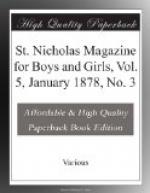[Illustration: SILK GLOVE-BOX.]
[Illustration: DIAGRAM SHOWING THE MANNER OF TUFTING THE LINING OF SILK GLOVE-BOX.]
A COAL-SCUTTLE PIN-CUSHION.
This droll little scuttle is made of black enamel cloth, cut according to the diagrams on next page. Fig. 1 is cut double and folded over at G. The two sides marked B and E in Fig. 1 are bound with black galloon; also the two sides marked with the same letters in Fig. 2.
[Illustration: COAL-SCUTTLE PINCUSHION AND NEEDLE BOOK.]
Before binding over, cast a bit of wire around the top and one around the bottom of the scuttle, and bend each into its proper shape. Figs. 3 and 4 are bound all round, and sewed over and over to the places indicated. Wrap two bits of wire, one four inches long and the other an inch and a quarter, with black worsted, and insert them through little holes made for the purpose to serve as the handles of the scuttle; stuff the inside firmly with hair or cotton-wool, cover the top with flannel, cut after Fig. 4, and button-hole the edges down all round with worsted of the color of the flannel. If you like to add a needle-book you can do so by cutting three leaves of differently colored flannels, after the shape of Fig. 4, snipping the edges into points, or button-holing them, and fastening the leaves to the back of the scuttle above the pincushion.
[Illustration: DIAGRAMS OF COAL-SCUTTLE PINCUSHION AND NEEDLE-BOOK. Fig. 1.—Pattern of Coal-Scuttle Pinchusion. Fig. 2.—Part of Pattern of Coal-Scuttle Pinchusion. Fig. 3.—Bottom of Coal-Scuttle. Fig. 4.—Top of Coal-Scuttle.]
A BIT OF PLAIN WORK.
There are notable little sempstresses even in these days of machines ("and I am thankful to know that there are,” says Mother Santa Claus) who set their stitches as swiftly and as precisely as ever their grandmothers did before them, and have the same liking for what used to be called “white seam.” To such we would suggest, what a nice and useful Christmas present would be a beautifully made under-garment. It need not of necessity be a shirt, though in old days no girl was considered educated who could not finish one all by herself, from cutting out to the last button-hole; but an apron or petticoat or dressing-jacket or night-gown, over which little fingers had labored deftly and lovingly, would, it seems to us, be a most wonderful and delightful novelty for mamma or grandmamma to find on the Christmas-tree this year. A set of handkerchiefs nicely hemmed and marked (girls used to cross-stitch the marks in their own hair!), or a soft flannel petticoat, cat-stitched at the seams, scalloped with coarse working cotton,—which grows whiter with washing, instead of yellowing like silk,—with three pretty initials on the waistband, would be other capital ideas. Try them.




